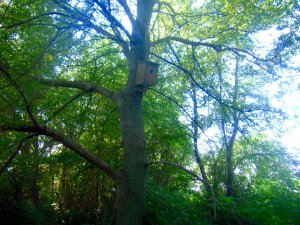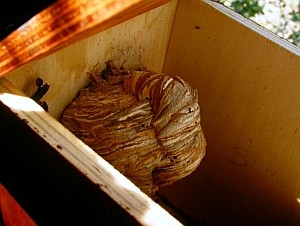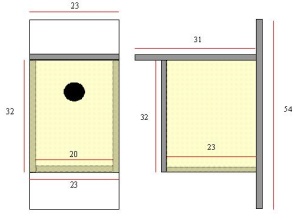Technical details
Banding station Download Links Wallpaper gallery Site mapTechnical details
Building nest boxes for Scops Owls and other species
Nest boxes of the Scops Owl project were realised following indications found in the book "Nidi artificiali" (Nest boxes) by Premuda, Bedonni and Ballanti, 2000 - Calderini.
General features. Internal measures are 20x23 cm (bottom) x30 cm (height). The entrance hole is 6 cm in diameter. The roof top is hinged to the back and can be opened to inspect nestbox content.
Materials. Nest-boxes are made with 1.5 cm thick multilaminated board. Advantages: wood easy to work, not expensive, flexible, when under strain tends to become bent without breaking. Disadvantages: short-lived, sensitive to humidity, needs regular maintenance; ants love it.
Realization. Pieces are glued and screwed together. Two or three hinges fix the roof top to the back and allow opening. Some holes are drilled through the bottom for water draining.

Nestbox no.2. Picture by E. D'Avino
Painting. On the outside only with non-toxic (water-based) protective paint.
Fixing. On a tree trunk or branch by means of wire wrapped around the box and trunk; protect the trunk from wire cutting in by the use of a piece of rubber. Advantages: fixing with wire easier than with nails or screws; no damage to the tree trunk; boxes can be taken down for cleaning or maintenance by simply cutting the wire. Disadvantages: regular monitoring of the wire tightness around the trunk is necessary to loosen it if too tight or replace it in case of break. Some tree species, notably pines and poplars, grow quickly: wire can cut into the bark and break and/or cause damage to the trunk.
Important: the nestbox should be mounted slightly tilted forwards to prevent rain from penetrating through the entrance hole or between top and back.
Bottom material. Owls and other cavity nesters lay eggs directly on the bottom of the cavity. Provide a nesting substrate by adding coarse sand or peat in the box. Do not use sawdust or wood shavings that may attract ants and are potentially dangerous for the chicks.
Duration. With the passing of time a nestbox exposed to rain, humidity, heat and insects gets damaged and after a few years in the open it tipically needs to be repaired or replaced with a new one. Attention must be paid to the fixing system: wires have to be checked regularly to minimise break risks and tree damage.

Hornet Vespa crabro hive in a nestbox. The internal side of the top had been rubbed with grease to hinder hive attachment; hornets overcame the problem by using the back wall (Monti della Tolfa, Latium - 2001). Picture by D. Centili
Other guests. Nestboxes are sometimes colonized by other less-welcome species. Hornets Vespa crabro especially can be unpleasant and even dangerous occupants.
A way to prevent hornets and wasps from colonising a nest box is to rub the inside walls with a greasy substance. The insects find it difficult to attach the hive stalk to the slippery surfaces.
A nest-box colonized by hornets may be opened safely in winter, after their life-cycle is finished and the hive has been abandoned. Then, the empty hive can be eliminated, necessary maintenance done, and one can hope the insects will not be there again next spring.

Nest box heavily infested with Acrobat Ants Crematogaster scutellaris (Monti della Tolfa, Latium - 2001). Picture by D. Centili
Ants Crematogaster scutellaris (Acrobat Ants) often enter wooden walls and chew them from inside.
Scops owls and Hoopoes appear to occupy nest-boxes even when these are heavily infested with ants.
Finally, Brown Rats Rattus rattus. In the Orbetello Nature Reserve, these mammals appear to spend the winter in a few nest-boxes every year and leave them in March-April.
It's never very amusing to look into a rat's eyes when inspecting a nestbox; this said, the biggest problem is that they stuff all available space with bulky nests made of leaves, pine needles, twigs that must be eliminated before the start of the birds' breeding season.
Go to the Banding station section

